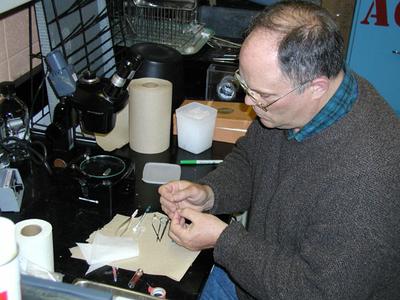1 May, 2002
Did anyone remember the definition of a snag?
A snag is a dead tree that is still standing. Snags were one of the major
places that we looked to find beetles and centipedes. The beetles are picky
about their dead trees and only live under the bark of dead Poplars. The
centipedes are for more widespread and can be found under the bark of just
about any tree type here.
While we were out collecting yesterday I got to see a number of examples of
adaptations to extreme environments. One of the photos being attached to this
entry is of a wild rose bush, very common around here. As you will see in the
photo, the bush has some very nasty spines. The growing season here is so
short that plants have to as much advantage of the season as they possibly
can. Consequently, they must also protect their growth from previous years,
otherwise the plants would have to start form ground level again every
season. To avoid this, the plants find ways to protect themselves. The spiny
wild rose is one example. One of the passages read in class this year was the
essay for February in the Sand County Almanac by Aldo Leopold. In that
passage Leopold spoke of the eternal battle between rabbits and young Oak
trees. As the Oaks try to grow, the rabbits chew them down to the ground. The
same situation exists here except that the role of the rabbit is played by
the Snowshoe Hare. Without some sort of defense, the plants would all be
chewed to the ground by the hares. Thus we have the spiny defenses of the
wild rose. One additional example that I am trying to get a photo of, is a
local willow bush. The willow produces a toluene based chemical that is toxic
to the hares (and to Moose as well). Examples of chemical and physical
defenses exist throughout these boreal woods.
Today for the most part has been a lab day. The snowfall predicted turned out
to be minor in this area, but the region around Toolik Lake is under a
blizzard advisory until this afternoon. The good news is that it will likely
be clear enough for driving by Saturday.
Today I learned how to take a blood sample from an insect. Actually, since
insects have an open circulatory system (for Biology students out there, an
open circulatory system isŠ?), the fluid being collected is called hemolymph.
It is a combination of a blood-like material and lymphatic fluid. I've
attached some photos of the process, but basically you clip off a small
segment of the insect and collect the ensuing droplets of fluid with a
capillary tube. A standard quantity for collection is about 3 micro liters.
This fluid will then be used to determine melting and freezing points for the
insect's hemolymph. This can tell us how active the antifreeze proteins are
in the insect. We also used a procedure to determine the actual freezing
point of the fluids inside the insect, but that is a process I'll
tell you about tomorrow.
Tomorrow we will be looking for new collection sites in the mountains around
Fairbanks and hopefully determining the cold tolerance characteristics of the
insects tomorrow evening.

A closer view of the bleeding process.

Dr. Jack Duman demonstrates the insect hemolymph collection technique.

This is a wild rose bush. Notice the impressive spines to protect it from Snowshoe Hares.

This is the larva of the Cucujus clavipes. (beetle)
Contact the TEA in the field at
.
If you cannot connect through your browser, copy the
TEA's e-mail address in the "To:" line of
your favorite e-mail package.
|
